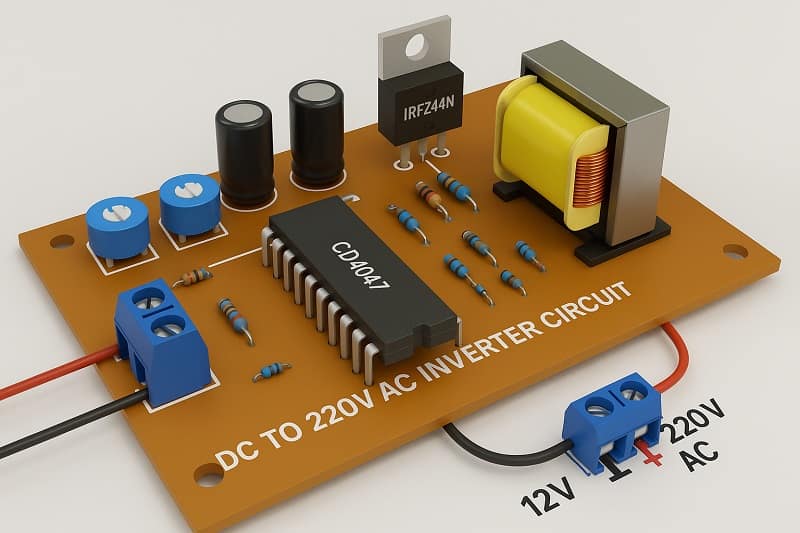12v DC to 220v AC Inverter Circuit using CD4047 IC & IRFZ44N
Learn everything about the 12V DC to 220V AC inverter circuit in this complete guide. Whether you are a beginner or an electronics enthusiast, understanding the 12V DC to 220V AC inverter circuit is essential for converting DC power from a battery into usable AC supply. This article covers the working principle of a 12V DC to 220V AC inverter circuit, required components, and a step-by-step explanation to build one yourself.
You will also find a detailed circuit diagram for the 12V DC to 220V AC inverter circuit along with safety tips and troubleshooting advice. By following this tutorial, you can design a reliable 12V DC to 220V AC inverter circuit for powering household devices, DIY projects, or emergency backup systems. The 12V DC to 220V AC inverter circuit is simple, practical, and highly useful.
Introduction.
In small electronics projects, converting DC to AC power is often essential. Even in large systems, designers need to transform DC voltages—especially in backup power setups. Take UPS systems, for example: they run on DC batteries but power AC appliances in our homes. The same goes for solar power and air conditioning systems, which often require AC output despite relying on DC sources.
That’s where inverters come in. These are electronic devices that convert DC into AC at a usable voltage. They’re simple, affordable, and easy to build. In this guide, we’ll walk through how to create a basic 12V DC to 220V AC inverter circuit using the CD4047 IC. There are many ways to design an inverter, but the CD4047 gives us a reliable and straightforward starting point.
Materials for the Project (12v DC to 220v AC Inverter Circuit)
- 1X CD4047
- 2X IRFZ44N
- 1X Transformer Step-up/12V 3A – 220V
- 1X Potentiometer 100K
- 1X LED 5 mm/3.5 V
- 2X Capacitor 1000 uF, 10 nF
- 5X Resistors 1K, 390K, 330 Ohm, 220 Ohm
- 1X Bulb 220V/LED
- 1X DC Battery 12V
- Jumper Wires
Download Circuit Diagram
CD4047 Pin
| Pin No. | Pin Name | Description |
|---|---|---|
| 1 | Astable Input A | Logic input for astable mode selection. |
| 2 | Astable Input B | Logic input for astable mode selection. |
| 3 | Astable Output | Output signal in astable mode. |
| 4 | Astable Input C | Logic input for astable mode control. |
| 5 | +Q Output | Main output in astable/monostable mode. |
| 6 | -Q Output | Complementary output (inverted of +Q). |
| 7 | Reset | Resets the output, active HIGH. |
| 8 | VSS (Ground) | Connected to ground (0V). |
| 9 | Cext | External capacitor terminal for timing control. |
| 10 | Rext | External resistor terminal for timing control. |
| 11 | Astable Control | Mode control input. |
| 12 | VDD (Supply) | Positive supply voltage (3V to 15V). |
| 13 | Trigger Input | Trigger pin for monostable mode (active edge-sensitive). |
| 14 | External Reset | Resets timing externally when connected properly. |
Working Explanation
In this circuit, the IC CD4047 is the central element. The IC is wired as an astable multivibrator. This has been achieved with the help of a potentiometer VR1 in the circuit. By varying this potentiometer and capacitor C1, one can get different ranges of output pulses at pins 10 and 11 of an IC. On the other hand, drain pins of MOSFETs are wired with the secondary of the transformer in the circuit. And, source pins are connected to the negative terminal of the battery.
Therefore, when the alternate pulses reach pins 10 and 11 of an IC, then it drives the MOSFETs. Hence, it forced the secondary winding to induce the alternate magnetic fields. As a result, the magnetic field produces a high alternate voltage of around 220 volts.
Applications
This simple inverter circuit has a range of practical uses, especially where backup or portable AC power is needed. Key applications include:
Emergency Power Supply: Used in low-cost UPS systems to keep essential appliances running during power outages.
Solar Power Systems: Converts stored 12V DC from batteries into 220V AC for home use.
DIY Portable Inverters: Ideal for building compact, battery-powered AC sources for travel or camping.
Educational Projects: Helps students and hobbyists understand power conversion and inverter design.
Battery-Operated Tools: Powers small AC tools or devices where mains power isn’t available.
Home Automation Projects: Useful in powering AC-based systems controlled by microcontrollers via DC sources.



